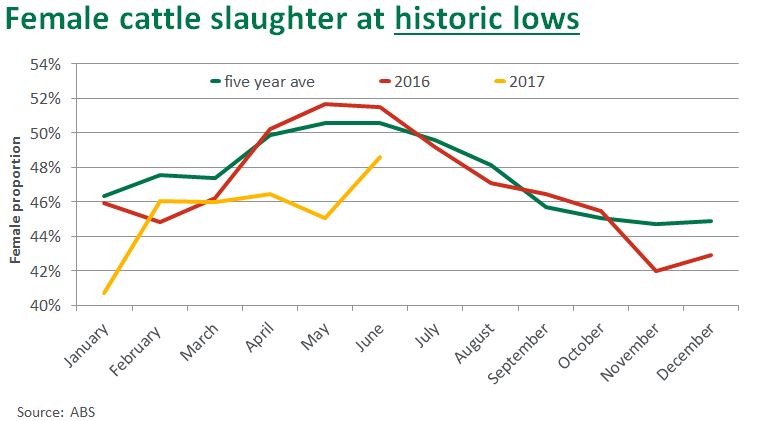Australian beef production shows signs of recovery
The combination of deteriorating seasonal conditions, recovering herd numbers and seasonal female turn-off resulted in Australian cattle slaughter and beef production registering its first year-on-year growth in two years.
A total of 658,985 adult cattle were processed throughout June, up 7% year-on-year. This rise, along with heavier carcases, resulted in an 11% increase in beef production which totalled 195,344 tonnes cwt for the month (ABS).
The increased number of cattle consigned to processors reflects the drying seasonal conditions and poor rainfall outlook for much of the country. Higher numbers of males processed drove the overall rise in June – up 13% to 338,914 head.
The higher number of males being slaughtered compared to year-ago levels has been apparent in recent months. However, looking at short term month-to-month change, the male proportion of the adult cattle kill has actually declined.
Female cattle slaughter was up 1% from last year, to 320,071 head – accounting for 49% of the Australian adult cattle kill during June. This proportion remains well-below both year-ago levels and the five-year average and is in line with the seasonal increase in female turn off.

The national average adult carcase weight increased 4% year-on-year in June, to 296.43kg/head. This reflected the greater number and proportion of cattle coming off feed given the tighter grassfed supply. In the March quarter MLA/ALFA lotfeeding survey, there were more than one million head on feed and early indications are that this number has grown throughout the June quarter. Cattle on feed have also been retained on feed for longer, further boosting carcase weights.
In terms of the 2016-17 financial year, slaughter and production were both hindered by the very low availability of cattle during the period.
Nationally, adult cattle slaughter totalled just over 6.9 million head for the 12 months to June, 15% lower year-on-year. The decline was predominantly attributed to 19% fewer females processed than the previous year – signalling the intention to retain females and herd rebuilding efforts. Meanwhile, male slaughter throughput declined 11% year-on-year.
Production was offset somewhat by a 4% (10.1kg) rise in the average adult cattle carcase weight, to 293.21kg/head. Nevertheless, beef production in 2016-17 eased 12%, to 2.05 million tonnes cwt – the lowest fiscal year volume since 2008-09.
For the remainder of 2017, slaughter and production is anticipated to remain above year-ago levels, due to deteriorating seasonal conditions and the poor rainfall outlook, particularly for southern Australia. Furthermore, supply constraints are expected to ease somewhat, as female retention results in some herd rebuilding and a greater proportion of cattle are consigned from the lot feeding sector.



